Functional Assessment and Patient-Related Outcomes after Gluteus Maximus Flap Transfer in Patients with Severe Hip Abductor Deficiency
Abstract
1. Introduction
2. Experimental Section
2.1. Patients
2.2. Clinical and Functional Evaluation
2.3. Patient-Reported Outcome Measures (PROMs)
2.4. Surgical Technique
2.5. Statistical Analysis
3. Results
3.1. Clinical and Functional Results
3.2. Patient-Related Results
3.3. Radiographic Results
4. Discussion
Limitations
5. Conclusions
Author Contributions
Funding
Acknowledgments
Conflicts of Interest
References
- Caviglia, H.; Cambiaggi, G.; Vattani, N.; Landro, M.E.; Galatro, G. Lesion of the hip abductor mechanism. SICOT J. 2016, 2, 29. [Google Scholar] [CrossRef] [PubMed][Green Version]
- Miozzari, H.H.; Dora, C.; Clarke, J.M.; Notzli, H.P. Late repair of abductor avulsion after the transgluteal approach for hip arthroplasty. J. Arthroplasty 2010, 25, 450–457. [Google Scholar] [CrossRef] [PubMed]
- Ricciardi, B.F.; Henderson, P.W.; McLawhorn, A.S.; Westrich, G.H.; Bostrom, P.M.; Gayle, L.B. Gluteus maximus advancement flap procedure for reconstruction of posterior soft tissue deficiency in revision total hip arthroplasty. Orthopedics 2017, 40, 495–500. [Google Scholar] [CrossRef] [PubMed]
- Odak, S.; Ivory, J. Management of abductor mechanism deficiency following total hip replacement. Bone Joint J. 2013, 95, 343–347. [Google Scholar] [CrossRef] [PubMed]
- Hellman, M.D.; Kaufman, D.J.; Sporer, S.M.; Paprosky, W.G.; Levine, B.R.; Della Valle, C.J. High rate of failure after revision of a constrained liner. J. Arthroplasty. 2018, 33, 186–190. [Google Scholar] [CrossRef] [PubMed]
- Berry, D.J.; Sierra, R.J.; Hanssen, A.D.; Sheth, N.P.; Paprosky, W.G.; Della Valle, C.J. AAHKS Symposium: state-of-the-art management of tough and unsolved problems in hip and knee arthroplasty. J Arthroplasty 2016, 31, 7–15. [Google Scholar] [CrossRef] [PubMed]
- Segal, N.A.; Felson, D.T.; Torner, J.C.; Zhu, Y.; Curtis, J.R.; Niu, J.; Nevitt, M.C. Multicenter Osteoarthritis Study Group. Greater trochanteric pain syndrome: epidemiology and associated factors. Arch. Phys. Med. Rehabil 2007, 88, 988–992. [Google Scholar] [CrossRef] [PubMed]
- Lievense, A.; Bierma-Zeinstra, S.; Schouten, B.; Bohnen, A.; Verhaar, J.; Koes, B. Prognosis of trochanteric pain in primary care. Br. J. Gen. Pract 2005, 55, 199–204. [Google Scholar] [PubMed]
- Williams, B.S.; Cohen, S.P. Greater trochanteric pain syndrome: a review of anatomy, diagnosis and treatment. Anesth Analg 2009, 108, 1662–1670. [Google Scholar] [CrossRef] [PubMed]
- Di Martino, A.; Geraci, G.; Stefanini, N.; Perna, F.; Mazzotti, A.; Ruffilli, A.; Faldini, C. Surgical repair for abductor lesion after revision total hip arthroplasty: a systematic review. Hip Int. 2019, 1120700019888863. [Google Scholar] [CrossRef] [PubMed]
- Beck, M.; Leunig, M.; Ellis, T.; Ganz, R. Advancement of the vastus lateralis muscle for the treatment of hip abductor discontinuity. J. Arthroplasty. 2004, 19, 476–480. [Google Scholar] [CrossRef] [PubMed]
- Whiteside, L.A. Surgical technique: transfer of the anterior portion of the gluteus maximus muscle for abductor deficiency of the hip. Clin. Orthop Relat Res. 2012, 470, 503–510. [Google Scholar] [CrossRef] [PubMed]
- Kohl, S.; Evangelopoulos, D.S.; Siebenrock, K.A.; Beck, M. Hip abductor defect repair by means of a vastus lateralis muscle shift. J. Arthroplasty 2012, 27, 625–629. [Google Scholar] [CrossRef] [PubMed]
- Drexler, M.; Abolghasemian, M.; Kuzyk, P.R.; Dwyer, T.; Kosashvili, Y.; Backstein, D.; Gross, A.E.; Safir, O. Reconstruction of chronic abductor deficiency after revision hip arthroplasty using an extensor mechanism allograft. Bone Joint J. 2015, 97, 1050–1055. [Google Scholar] [CrossRef] [PubMed]
- Elbuluk, A.M.; Coxe, F.R.; Schimizzi, G.V.; Ranawat, A.S.; Bostrom, M.P.; Sierra, R.J.; Sculco, P.K. Abductor Deficiency-Induced Recurrent Instability After Total Hip Arthroplasty. JBJS Rev. 2020, 8, e0164. [Google Scholar] [CrossRef] [PubMed]
- Prodinger, B.; Taylor, P. Improving quality of care through patient-reported outcome measures (PROMs): expert interviews using the NHS PROMs Programme and the Swedish quality registers for knee and hip arthroplasty as examples. BMC Health Serv Res. 2018, 18, 87. [Google Scholar] [CrossRef] [PubMed]
- Rolfson, O.; Eresian Chenok, K.; Bohm, E.; Lübbeke, A.; Denissen, G.; Dunn, J.; Lyman, S.; Franklin, P.; Dunbar, M.; Overgaard, S.; et al. Patient-reported outcome measures in arthroplasty registries. Acta Orthop. 2016, 87, 3–8. [Google Scholar] [CrossRef] [PubMed]
- Goutallier, D.; Postel, J.M.; Bernageau, J.; Lavau, L.; Voisin, M.C. Fatty muscle degeneration in cuff ruptures. Pre- and postoperative evaluation by CT scan. Clin. Orthop Relat Res. 1994, 304, 78–83. [Google Scholar]
- Harris, W.H. Traumatic arthritis of the hip after dislocation and acetabular fractures: treatment by mold arthroplasty. An end-result study using a new method of result evaluation. J. Bone Joint Surg Am. 1969, 51, 737–755. [Google Scholar] [CrossRef] [PubMed]
- Janda, V. On the concept of postural muscles and posture in man. Aust J. Physiother. 1983, 29, 83–84. [Google Scholar] [CrossRef]
- Madsen, M.S.; Ritter, M.A.; Morris, H.H.; Meding, J.B.; Berend, M.E.; Faris, P.M.; Vardaxis, V.G. The effect of total hip arthroplasty surgical approach on gait. J. Orthop Res. 2004, 22, 44–50. [Google Scholar] [CrossRef]
- Lachiewicz, P.F. Abductor tendon tears of the hip: evaluation and management. J. Am. Acad Orthop Surg. 2011, 19, 385–391. [Google Scholar] [CrossRef] [PubMed]
- Elmallah, R.K.; Chughtai, M.; Adib, F.; Bozic, K.J.; Kurtz, S.M.; Mont, M.A. Determining Health-Related Quality-of-Life Outcomes Using the SF-6D Following Total Hip Arthroplasty. J. Bone Joint Surg Am. 2017, 99, 494–498. [Google Scholar] [CrossRef] [PubMed]
- Ware, J.E., Jr.; Kosinski, M.; Bayliss, M.S.; McHorney, C.A.; Rogers, W.H.; Raczek, A. Comparison of methods for the scoring and statistical analysis of SF-36 health profile and summary measures: summary of results from the Medical Outcomes Study. Med. Care. 1995, 33, 264–279. [Google Scholar]
- Jensen, M.P.; McFarland, C.A. Increasing the reliability and validity of pain intensity measurement in chronic pain patients. Pain 1993, 55, 195–203. [Google Scholar] [CrossRef]
- Wang, K.; Cole, S.; White, D.C.; Armstrong, M.S. Vastus lateralis transfer for severe hip abductor deficiency: a salvage procedure. Hip Int. 2014, 24, 180–186. [Google Scholar] [CrossRef] [PubMed]
- Pearson, K.; Lee, A. On the laws of inheritance in man. I. Inheritance of physical characteristics. Biometrika. 1902, 2, 357. [Google Scholar] [CrossRef]
- Whiteside, L.A.; Roy, M.E. Incidence and treatment of abductor deficiency during total hip arthroplasty using the posterior approach: repair with direct suture technique and gluteus maximus flap transfer. Bone Joint J. 2019, 101, 116–122. [Google Scholar] [CrossRef] [PubMed]
- Chandrasekaran, S.; Darwish, N.; Vemula, S.P.; Lodhia, P.; Suarez-Ahedo, C.; Domb, B.G. Outcomes of gluteus maximus and tensor fascia lata transfer for primary deficiency of the abductors of the hip. Hip Int. 2017, 27, 567–572. [Google Scholar] [CrossRef] [PubMed]
- Boettner, F.; Cross, M.B.; Nam, D.; Kluthe, T.; Schulte, M.; Goetze, C. Functional and Emotional Results Differ After Aseptic vs Septic Revision Hip Arthroplasty. HSS J. 2011, 7, 235–238. [Google Scholar] [CrossRef] [PubMed]
- Rietbergen, L.; Kuiper, J.W.; Walgrave, S.; Hak, L.; Colen, S. Quality of life after staged revision for infected total hip arthroplasty: a systematic review. Hip Int. 2016, 26, 311–318. [Google Scholar] [CrossRef] [PubMed]
- Parvizi, J.; Ghanem, E.; Azzam, K.; Davis, E.; Jaberi, F.; Hozack, W. Periprosthetic infection: are current treatment strategies adequate? Acta Orthop Belg. 2008, 74, 793–800. [Google Scholar] [PubMed]
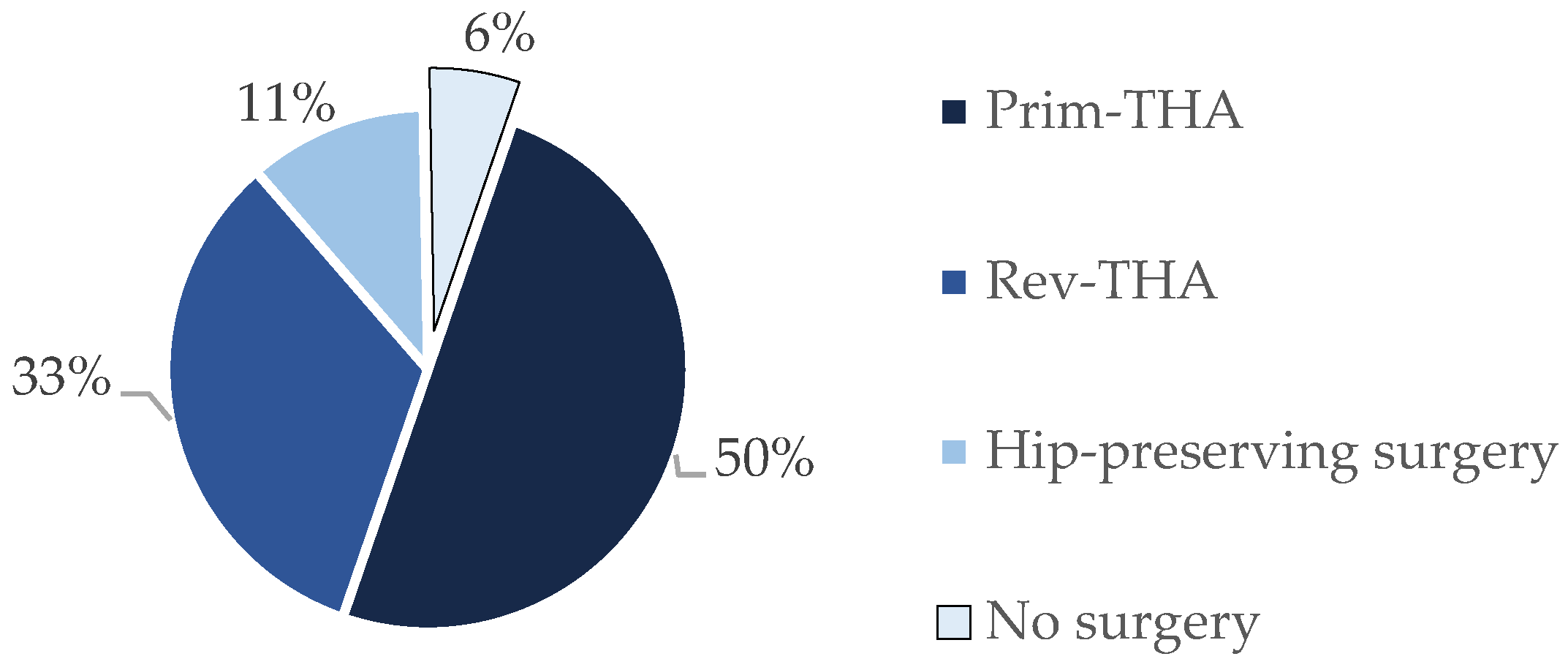
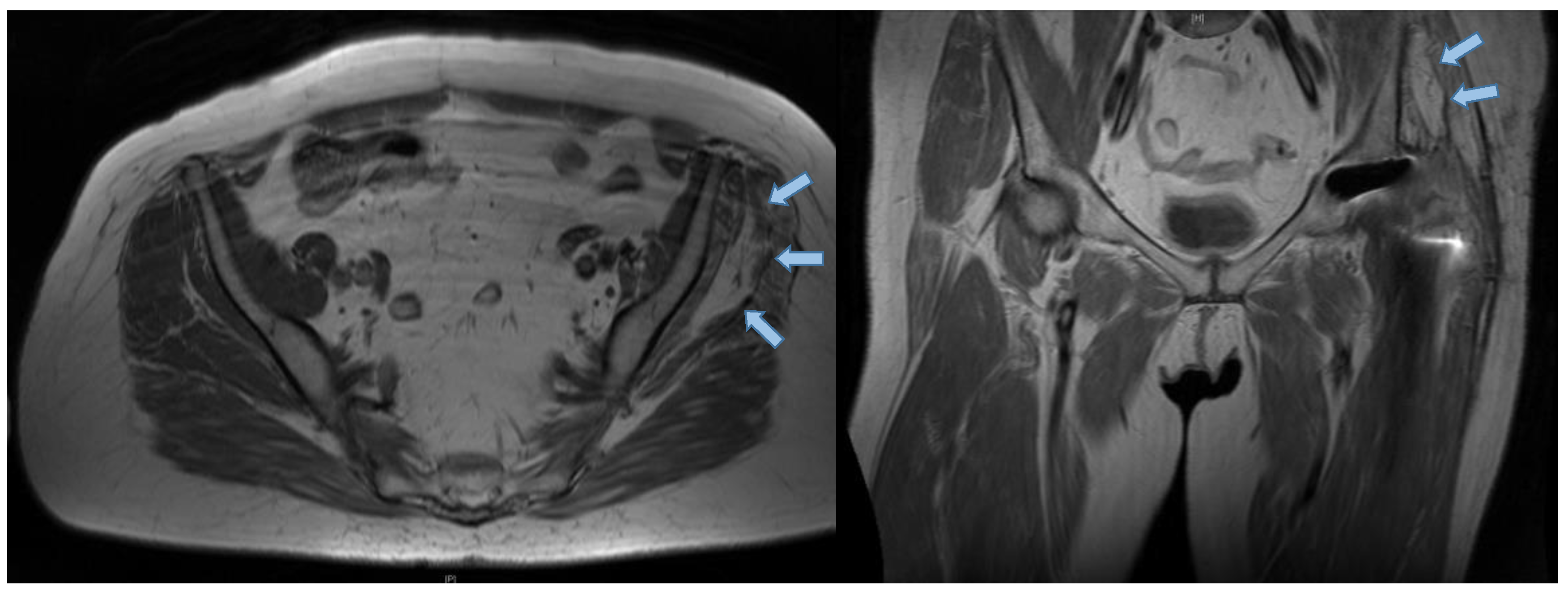
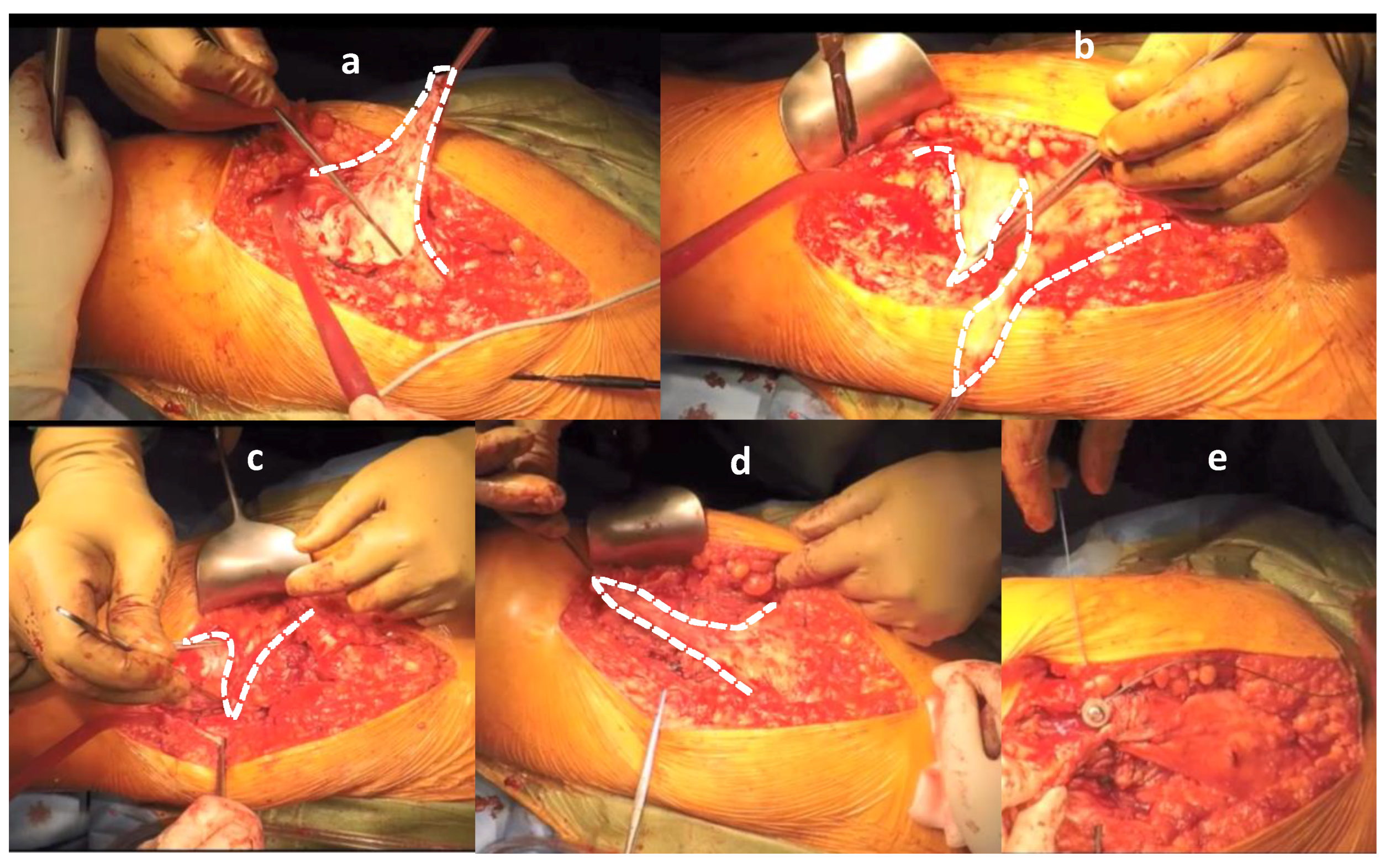
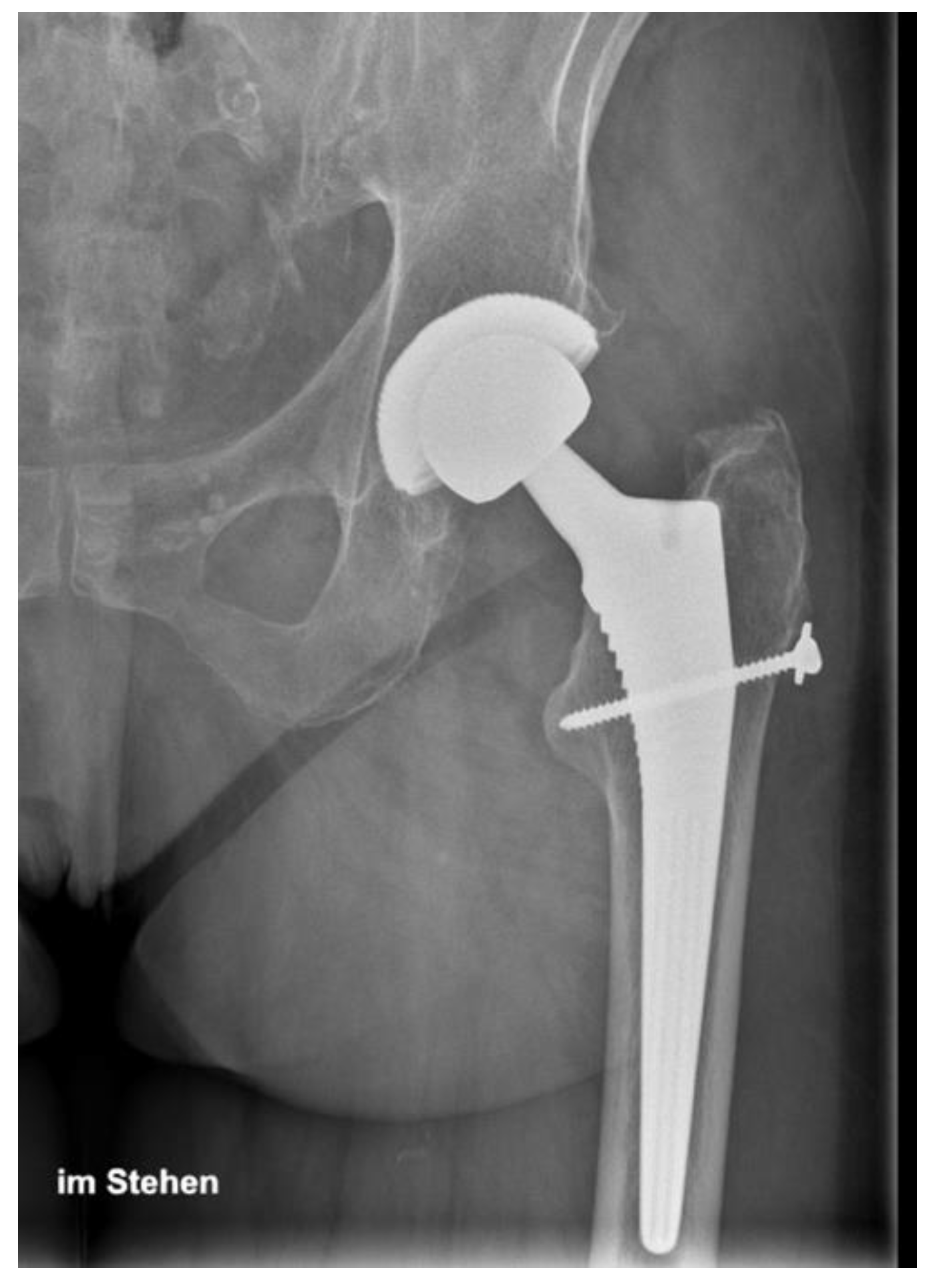
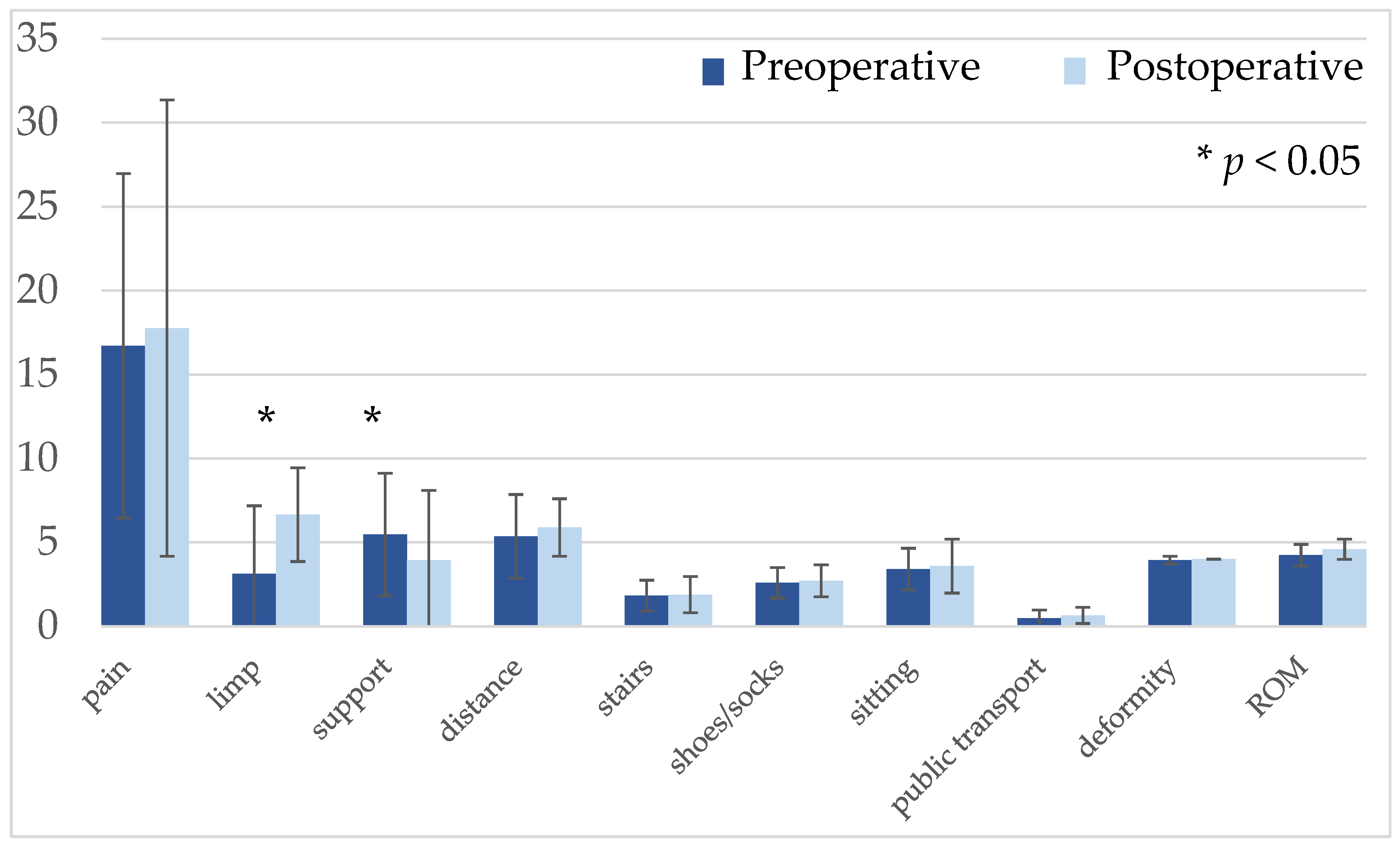
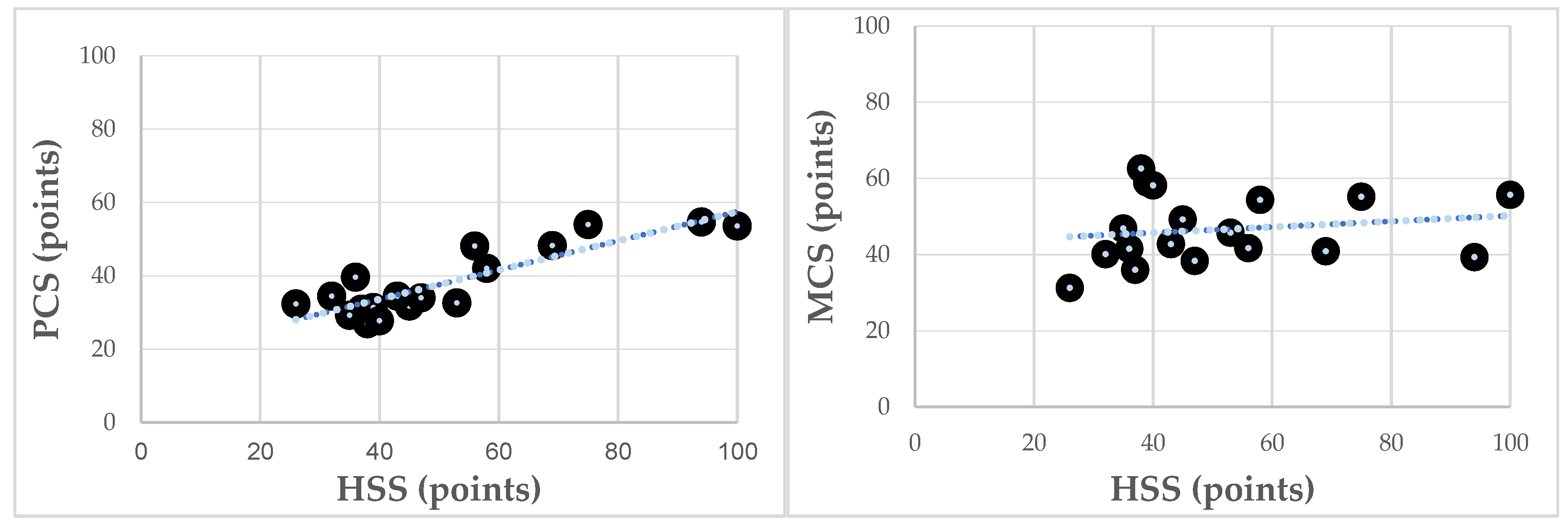
| Demographics | n = 18 |
|---|---|
| Sex M/F, n (%) | 5 (28%)/13 (72%) |
| Age (years), mean (range) | 64 (53‒79) |
| BMI (kg/m2), mean (range) | 26.7 (20–37) |
| Prior hip surgeries, mean (range) | 2.2 (0–5) |
| Pain (NRS 0‒10), mean (range) | 6.1 (0–10) |
| Preoperative | Postoperative | p-Value | |
|---|---|---|---|
| Harris Hip Score, mean (range) | 47.1 (22–94) | 51.1 (26–100) | 0.42 |
| Pain (NRS), mean (range) | 6.1 (0–10) | 4.9 (0–8) | 0.25 |
| Abduction Strength (Janda), mean (range) | 2.7 (1–5) | 2.8 (2–5) | 0.32 |
| Authors | Study Design | n of Patients | Mean Follow-up (Range) | Clinical Evaluation | PROMs | Radiographic Evaluation (MRI) |
|---|---|---|---|---|---|---|
| Whiteside et al. [13] (2012) | Prospective single center study | 11 | 33 (16‒42) | Trendelenburg Sign, Abduction strength | n.a. | n.a. |
| Ricciardi et al. [3] (2017) | Retrospective single center study | 7 | 17 (6‒37) | Trendelenburg Sign, Abduction strength | n.a. | n.a. |
| Chandrasekaran et al. [30] (2017) | Retrospective single center study | 3 | 25 (15‒30) | HOS-SSS, NAHS | mHHS | n.a. |
© 2020 by the authors. Licensee MDPI, Basel, Switzerland. This article is an open access article distributed under the terms and conditions of the Creative Commons Attribution (CC BY) license (http://creativecommons.org/licenses/by/4.0/).
Share and Cite
Ruckenstuhl, P.; Wassilew, G.I.; Müller, M.; Hipfl, C.; Pumberger, M.; Perka, C.; Hardt, S. Functional Assessment and Patient-Related Outcomes after Gluteus Maximus Flap Transfer in Patients with Severe Hip Abductor Deficiency. J. Clin. Med. 2020, 9, 1823. https://doi.org/10.3390/jcm9061823
Ruckenstuhl P, Wassilew GI, Müller M, Hipfl C, Pumberger M, Perka C, Hardt S. Functional Assessment and Patient-Related Outcomes after Gluteus Maximus Flap Transfer in Patients with Severe Hip Abductor Deficiency. Journal of Clinical Medicine. 2020; 9(6):1823. https://doi.org/10.3390/jcm9061823
Chicago/Turabian StyleRuckenstuhl, Paul, Georgi I. Wassilew, Michael Müller, Christian Hipfl, Matthias Pumberger, Carsten Perka, and Sebastian Hardt. 2020. "Functional Assessment and Patient-Related Outcomes after Gluteus Maximus Flap Transfer in Patients with Severe Hip Abductor Deficiency" Journal of Clinical Medicine 9, no. 6: 1823. https://doi.org/10.3390/jcm9061823
APA StyleRuckenstuhl, P., Wassilew, G. I., Müller, M., Hipfl, C., Pumberger, M., Perka, C., & Hardt, S. (2020). Functional Assessment and Patient-Related Outcomes after Gluteus Maximus Flap Transfer in Patients with Severe Hip Abductor Deficiency. Journal of Clinical Medicine, 9(6), 1823. https://doi.org/10.3390/jcm9061823






